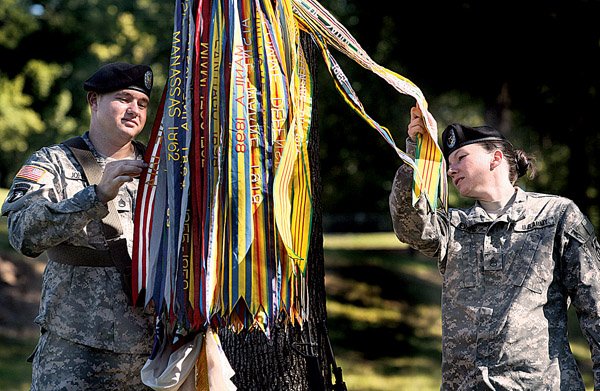LITTLE ROCK — Sgt. 1st Class Andy Knote took the flag tucked tightly in its canvas casing from his sergeant major Saturday and slowly walked through a cloud of smoke toward Camp Pike's historic gate in North Little Rock.
His gait was slow and deliberate as he carried the banner under which thousands of soldiers have fought over the past century through the gate and down a small path before disappearing into the woods.
The crowd of soldiers, veterans and civilians slowly rose to their feet in reverence as Knote walked away, the morning sun dappling his World War II-era uniform and steel helmet. His sleeve bore the patch of the "Tough 'Ombres," as the Army Reserve's 90th Regional Readiness Command and its predecessor, the 90th Infantry Division, are known.
Soldiers of the 90th wearing identical uniforms to Knote's stormed the beach at Normandy in World War II.
The 90th entered the annals of history again Saturday when the Army Reserve pulled it out of service as part of an overall restructuring of its major commands. The 90th was inactivated after World War I and World War II.
"We should not bid farewell to the 90th," said Brig. Gen. Christopher Cline, the 90th's commander, "but hope it may come back again."
330478
http://focus.arkans…">
Maj. Gen. James Sholar, former 90th commander and current deputy commanding general of the U.S. Army Reserve Command, echoed that sentiment, telling the crowd that he carries his 90th patch in his pocket just in case.
The 90th has called Camp Pike home since 1996, after the last Army Reserve reorganization that moved it from San Antonio. The 90th Infantry Division was activated during World War I, where it gained its nickname Tough 'Ombre in the trenches of France. The unit patch has always been a combination of the two letters "T" and "O."
The 90th Infantry Division became the 90th Army Reserve Command in 1968 after a major restructuring of Reserve units.
With the move to Arkansas in 1996, the 90th became a regional readiness command,encompassing more than 17,000 troops in five states and was one of 10 major commands in the Army Reserve. More than 600 soldiers reported to the 90th's headquarters at Camp Pike.
The Army Reserve's restructuring plans call for just four major commands to oversee facilities, land and infrastructure with new, specialized commands activated for each type of unit.
"What the Army Reserve has done is cut the overhead," said Col. Jim Beesley, the 90th's chief of staff. "It's good business practice."
Over the past four years, the 90th's units have been shifted to those specialized, operational commands, with all military police units in the nation falling under one command, and medical units under another and so on.
The 90th has been the temporary operational command for all 32 legal services units in the Army Reserve. Within the next few months, the permanent legal services headquarters will be set up elsewhere and the remaining 90th soldiers like Knote and Beesley will head to assignments in other states.
The 90th isn't completely gone, however.
The Army Reserve created the 90th Sustainment Brigade at Camp Pike as part of its reorganization. The 310-soldier brigade is trained to oversee sustainment operations in deployed areas, such as logistics, supply and base operations. The 90th brigade, which falls under a sustainment operation command, left last month to Fort Hood, Texas, where it is preparing to deploy to Iraq next year.
"The history of the Army is evolution and change," Sholar told the crowd Saturday. "The history of the Army Reserve is evolution and change. The history of the 90th is evolution and change."
Sholar added: "This is certainly an emotional, if not traumatic event for everyone who has worn the patch."
Sitting in the audience, three World War II veterans quietly watched the 90th flag flap in the breeze as the general spoke. They'd been on the beach at Normandy on D-Day. They'd marched through France and Belgium with the 90th's Tough Ombre patch on their sleeves.
One of those veterans, Tom Ridlehuber, gave the ceremony's invocation, praying that "God watch over the flag as it is encased and that it be activated again soon."
After the ceremony, soldier after soldier - many of whom fought in wars long after Ridlehuber - walked up to thank the World War II veteran and his buddies for what they did.
Ridlehuber smiled at his fellow soldiers, clasped each hand with a firm grip and readily offered stories of walking through Normandy and eventually Belgium with his various platoons before getting injured in the last days of the war.
His fellow soldiers absorbed his memories with the eager ears and anxious eyes of men who know war as well as the man they listened to.
Knote emerged from the path he had wandered down with the 90th flag as Ridlehuber greeted people, and stood quietly at a distance, his hands empty, an M-1 rifle slung over his shoulder.
"To get to play this role for this ceremony is really a privilege, both to wear this," Knote said, pointing to the historic wool uniform the 90th historians had given him to wear, "and to do this," he said, looking up the path where he carried the cased 90th flag for the last time.
Arkansas, Pages 15, 18 on 08/23/2009
